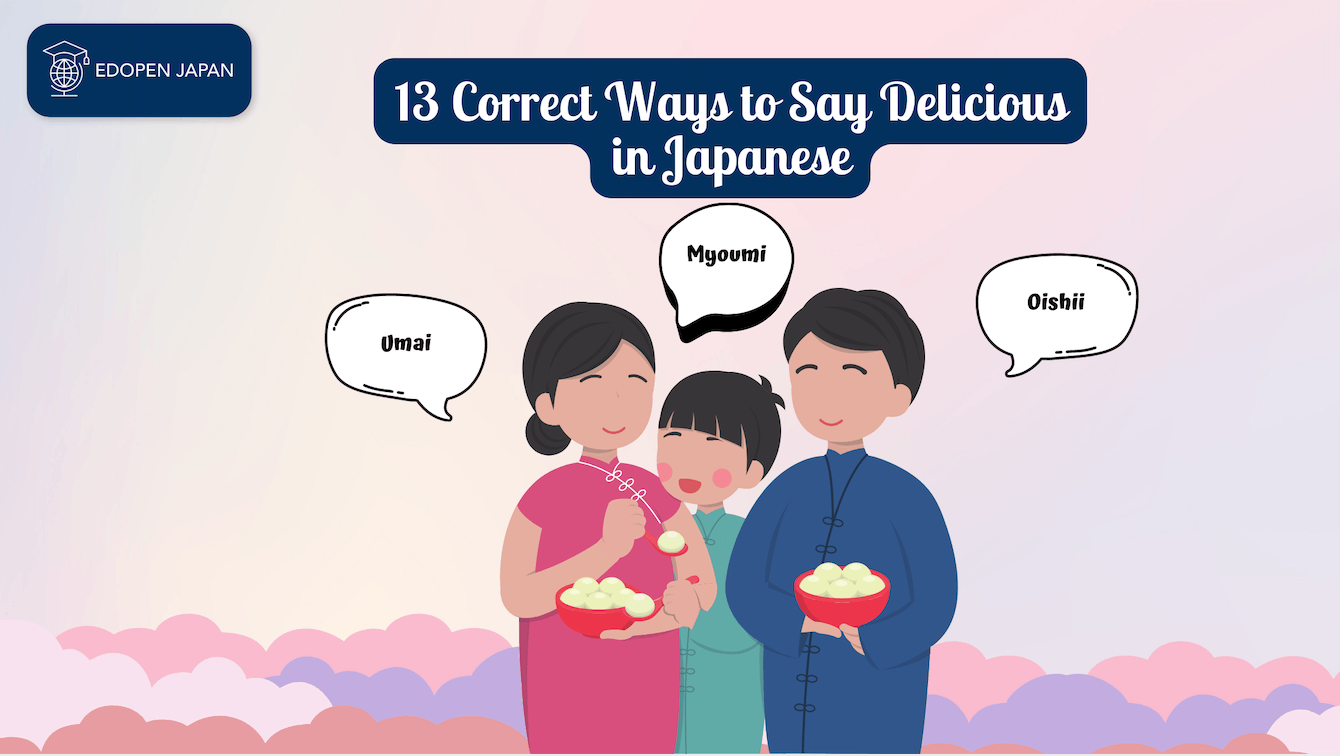Japanese food has gained worldwide popularity in recent years, so much so that in some countries, the mere act of eating raw fish is considered eating it “Japanese style”.
Besides the most commonly known, sushi or Japanese ramen, Japanese cuisine has a whole variety of foods and flavors that vary from region to region, so it is expected that there are a lot of different words to describe the flavors and tastiness of food in Japanese.
In this article, we will go over the different ways to explain that a dish is tasty in Japanese, as well as the different ways to explain flavors and the ways to explain more complex flavors. There will also be a small section that explains different vocabulary for cooking, as if you find something so delicious that you want to ask and understand how to cook it yourself.
Also, many Japanese dishes are just a series of simple steps that are easy to follow and prepare with a little skill. As they say, easy to start, but hard to master. But this way, even if you are not in Japan, you can still try to eat some Japanese food.
In addition, for those of you who are currently studying Japanese, especially certain vocabulary and phrases that are very common in everyday Japanese conversation, please also check out our reading recommendations below!
Then, especially for those of you who really love Japanese snacks, or currently really need comprehensive information about updated and trusted Japanese snacks, we have special recommendations for you. The following is one of the best websites that you can visit to find out details about the best choices of Japanese snacks: It is The Japanese Snacks Lab!
As the name proves, this site provides the information you really need about Japanese snacks. The information suggested is very detailed, renewed and specially developed by a student at one of the best universities in Tokyo. The author provides the information you really need regarding recommendations for various typical snacks in Japan, starting from the best vegan snacks, the best healthy snacks, the best chocolate snacks, the newest ones, even recommendations for the best halal snacks and many more.
You will get a strong and comprehensive guide and discussion about snacks in Japan by reading this article from the author, who also has an official Level 3 dietary advisor certificate. Visit the following link to read the latest article presented by Japanese snacks lab!
Read also:
What’s the Beautiful Meaning of Gochisousama?
Everything You Need to Know about すごい (Sugoi)
What’s the Meaning of “Sasuga” (さすが)?
Contents
What is delicious in Japanese?
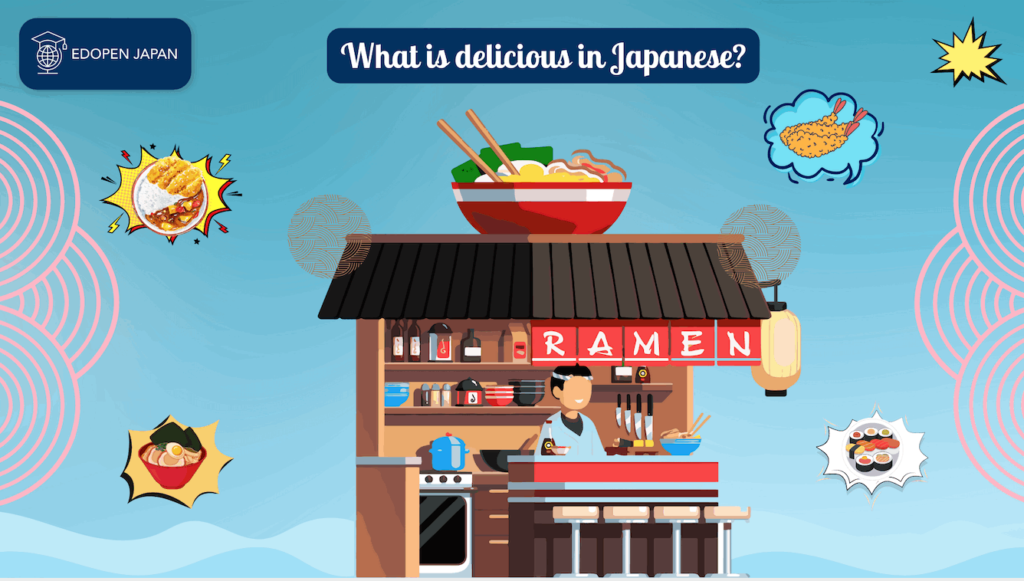
First of all, we will explain the different words that are used in Japanese to explain that something is good together with a short explanation of their use.
(1) おいしい (美味しい) oishii
This is the most known and the most common word for explaining that something is delicious, it literally means just that, it is also considered formal enough to be used by people above you and with respect. This word does not convey any information or description of a dish, it is only saying that it has a good taste. Please see the example of sentences below.
- ___はおいしい(です)
___ha Oishii (desu)
___ is delicious.
(2) 妙味 (myoumi)
Exquisite is a word to explain a delicate and charming flavor of food, it is mostly used when talking about high-class food, so going to a good and renowned restaurant and it wouldn’t be taken seriously if you were to use it to refer to fast food as it will instead sound as being sarcastic or joking. Please see the example of sentences below.
- __妙味がある。
__ myoumi ga aru.
It is exquisite. - _妙味を感じる。
__Myoumi wo kanjiru.
It gives of exquisiteness.
(3) 絶品 (zeppin)
It is a word used to refer to what you would consider a masterpiece or the best of the best, it is not only limited to food, but some food chains like to refer to their best dish or most popular one as their “Zeppin”.
It is good to know this word in the food context is mainly used in advertisements, but because of its common use by fast-food restaurants to refer to their tastiest yet item, it wouldn’t be used in a luxury restaurant. But it can be used to refer to the best of a certain type of food too.
- __はあの店の絶品 (です)。
__ ha Ano mise no Zeppin (desu).
__ is that store’s best dish.
(4) いい味 or よい味 (ii aji or yoi aji)
Literally formed of the combination of “good” and “flavor” this word is used just to refer that someone has a good taste. Again, it does not convey any specific level, class, or type of food in question.
- __いい味(が)する。
__ ii Aji (ga) suru.
__ has a good taste.
(5) ウマイ・旨い・ウマい (umai)
Umai is a word used to refer to food when it has a good taste, as well as Oishii, but the difference from oishii is the level of formality.
(6) 風味がよい (fuumi ga yoi)
This word literally represents that something is tasty by saying the taste by 風味 means that not only the taste with your tongue but also the aromas that emanate from the food are pleasant to the person that is about to consume them, it is also because of this feeling of this word in specific that 風味がよい is not commonly used by people in everyday life when referring to a normal meal.
However, by people who are foodies or that are trying to describe the flavor in any kind of media, it is not an expression said normally when eating at a fast-food burger restaurant or something of the like.
Fuumi Ga yoi is used as a descriptive word by itself so it is common to present exactly after the name of the food and a の (no), for example, __の風味がよいです。__no fuumi ga yoi desu.
(7) いける (ikeru)
This word comes from a normal expression in the west area of japan of explaining that *it goes* or * it a go* in some regions, there is the idiom in English that *it flies* to explain that something can or could be done. In this case, this expression would be used to express *it does work* this expression is normally used when trying something for the first time.
And more specifically when you wouldn’t be sure if it would taste good or not, such as Chocolate flavored potato chips, or unusual stuff that you wouldn’t normally consume such as insect protein, etc. in this case, after tasting it for the first time you can say “いける” to express that it was good or at least passable enough that is better than what you expected.
(8) コクがある (koku ga aru)
This one could be explained as the Japanese version of “packs a punch” or “strong flavor”, it does not mean that it is overly flavored or extremely oriented to one flavor, but instead, it means that the flavor it is oriented to have depth, and especially in Japanese cuisine that is constantly referred as “clean” and with subtle flavors.
The contrast would be for example a Ramen bowl that is full of flavor, so in those cases, the best way to explain that it has a strong tasty flavor would be コクがある (koku ga aru).
(9) 乙な味 (otsu na aji)
This one is one that is ambiguous in its meaning, as if meaning that is tasty or not, but for now it means that it presents a strange or spicy flavor. It could mean that it has a flavor that you wouldn’t expect from the dish or that it is spicier than what you imagined, it could be good or bad, but it mostly means that it has a surprising taste that you wouldn’t expect in that food. We recommend avoiding using this one as it is a bit on the edge of saying that it doesn’t taste good.
(10) やばい (yabai)
Yabai, making another appearance (Check our post about Yabai and its wide variety of meanings and uses for more information), this almighty word is commonly used by the younger generation to explain the tastiness of the food. As always, Yabai can be used to indicate tastiness or the lack of it from a portion of food. The meaning changes depending on the intonation of the word itself.
For example, using “this cake is Yabai!” with a happy tone, would mean that the cake itself tastes really good. Meanwhile, using “this tastes Yabaaai” with a disgusted tone would mean that it isn’t tasty at all and it’s bad.
But normally when recommending a place or if someone says “この前ヤバイなレストラン行ってきたよ!“ (Kono mae, yabai resutoran ittekita yo!)“ just a while ago I went to a Yabai restaurant!” would mean that they are saying that the restaurant itself was really good, and it is normally used with a positive tone.
More about Yabai, why you should avoid using it too much?
As always, Yabai is your good friend when you don’t know how to say that something is tasty or not, or that you just don’t want to use the most common words, in that case just a simple やばいね!”Yabai, ne!” Would be a good way to say that you liked it to the people that are near you.
Just remember that Yabai mainly has a negative connotation with the older generations, so in that case, just try to avoid using it with people that seem older.
If you were to do so, it might end up being misunderstood by them and would instead think that you are saying that it doesn’t taste good or that It was not up to your tastes.
(11) 極上の味 (gokujou no aji)
It could literally be translated as “first-rate” or “finest taste. This word is mainly used to describe a taste that is the best a restaurant or type of food can offer, and is usually used by critics or the restaurants themselves to refer to the tastiest, albeit more expensive dish on their menu.
It is also used to refer to those places that cook ordinary food to a higher quality than the norm, for example an expensive burger place compared to a certain clown-themed burger place.
(It does not mean that one is better than the other, just that one has a more “refined taste”. This phrase also appears in the anime, as well as in the manga, as a phrase used to mock someone’s taste by saying that they can’t comprehend the tastiness of something more expensive, especially used by the “rich lady kind of character”.
(12) 味わい深い (ajiwai fukai)
This word could be seen as the opposite of the previously seen word of コクがある (Koku ga aru), this one instead refers to food that presents subtle flavors and different undertones, especially referring to the use of different layers of flavors of certain foods. It can be used to refer to the taste of something that has an explicit aftertaste that could be perceived as intentional.
This word, together with the previously shown 極上の味 (Gokujou no Aji), are words used to refer to a fine-tasting kind of food, and it is normal to hear this word when someone is discussing the taste of expensive or “exquisite” food. It does not convey whether you liked it or not, but only expresses that there are many subtle flavors appearing in the food itself.
(13) 風味 (fuumi)
風味 (Fuumi) by itself is used to express that it “tastes like” some different food or that it has a taste that was given to it. This word is more than used by people to refer to good-tasting food it is used to describe when a food or a drink has a taste that is not authentic or that what you are consuming is not necessarily made with the ingredients of the flavor that it presents.
Additionally, this phrase is mostly used by companies to advertise flavors, typically of higher quality or more expensive ingredients, that were introduced to the food by the means of additives or small quantities of the ingredient in question.
More about Fuumi, how to appropriately use this phrase?
For example, it is common to see margarine in the store that says バター風味 (Bataa fuumi) “Butter fuumi”. This wording is especially noticeable when it comes to cheese, which is something relatively expensive in the Japanese grocery store. チェダー風味 (chedaa fuumi) “cheddar flavor” or マスカルポーネチーズ風味 (mascarpoone chiizu fuumi) “mascarpone cheese fuumi”.
Another common use is in the myriad of weird and varied flavors of potato chips that can be found in Japanese convenience stores, one of which is 和牛肉風味 (Wagyuuniku Fuumi) “Japanese Cow Beef Fuumi”.
It should also be noted that sometimes companies use sneaky techniques of adding the 風味 in the smallest font they can use to sell you something as if it has that actual ingredient instead.
Words for expressing flavors in Japanese
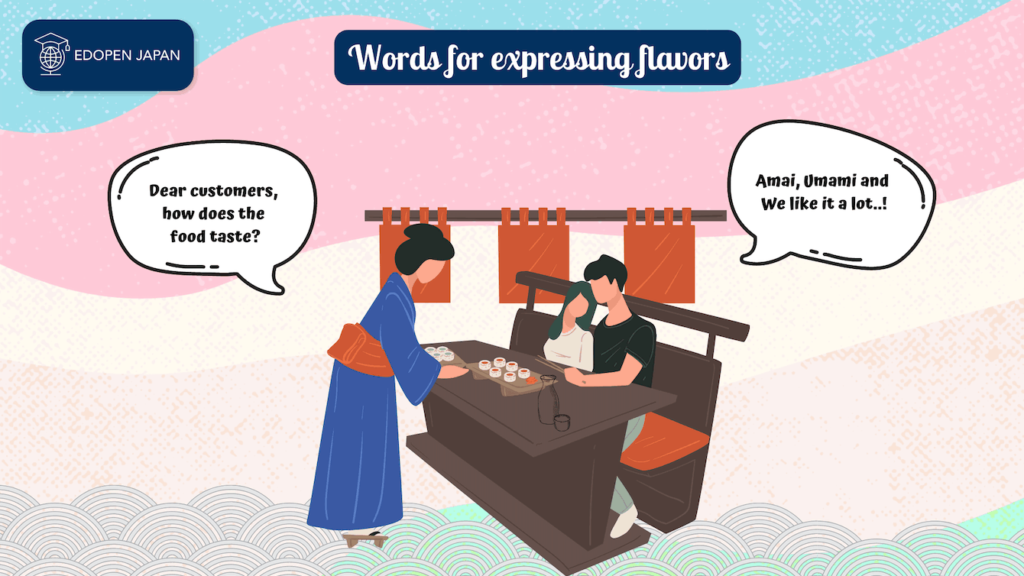
In addition to the different words in Japanese that indicate that something is tasty, there is sometimes a need to be able to explain the different tastes of something or what the main taste of some foods is. Especially when explaining common foods that have a slight twist.
Or they’ll come in handy when explaining an international or exotic dish to someone who hasn’t tried it, or wants to know more or less what it tastes like before waiting in line for 3 hours only to find out that the expensive and unique dish isn’t their cup of tea.
| Japanese | Pronunciation | Meaning |
| 甘い | Amai | Sweet |
| 辛い | Karai | Spicy |
| 酸っぱい | Suppai | Sour |
| 旨味、うま味 | Umami | Umami flavor |
| 苦い | Nigai | Bitter |
| 甘辛い | Amakarai | Spicy sweet |
The levels of spiciness in Japanese
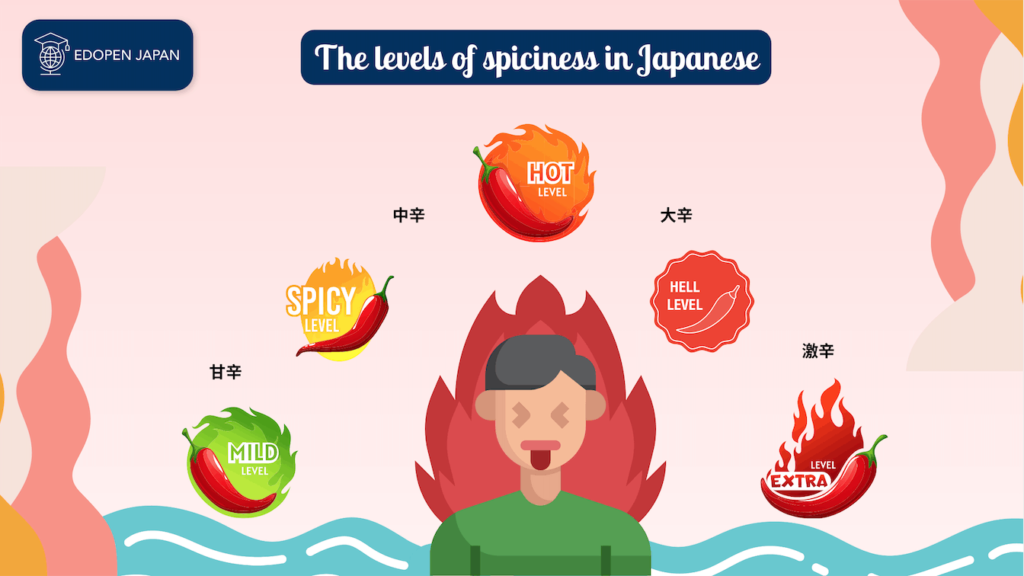
In Japan, there is a common list of words used to employ the level of spiciness of one food that could come in different variations of spiciness. But this scale is mostly used in curry and spices. Interestingly, this scale is also used as a way to measure the difficulties in games or puzzles.
The list will be from the least spicy to the spiciest ones. These are the most common ones but there are some extra or alternatives in-between used by certain brands or stores just for fun or for dividing the scale into more options.
(1) 甘辛 (Amakara – Sweet Spicy)
It is used to say that it is sweet with a tad of spiciness, but in truth, it is mostly sweet and not spicy at all. Commonly used as the lowest level of spiciness in an instant curry pack or retort pouch.
(2) 中辛 (Chuukara – Medium Spiciness)
This phrase is used to refer to the medium level of spiciness on a 3 step scale. When a spiciness scale has more than 3 levels, this one does not mean exactly the middle-level spiciness but instead the next after the sweetest one. So 中辛 could be considered to mostly be the one that goes after甘辛.
(3) 大辛 (Ookara – High Spiciness)
This phrase is used at the highest level when it comes to just 3 level scale of spiciness, but when it is more than 3 it is normally the one next 中辛. It is the first one on the scale where there is actually a good level of spiciness to become too much for some people who are not good with spicy stuff.
(4) 激辛 (Gekikara – Extremely Hot)
It is considered out of the 3-step scale, but it is one of the highest in spiciness, it is really spicy and it is also considered the word to use to refer to the highest difficulty setting in some games. This word could also be used to refer to really harsh criticism or review.
Do you like it or do you dislike it, that is the question?
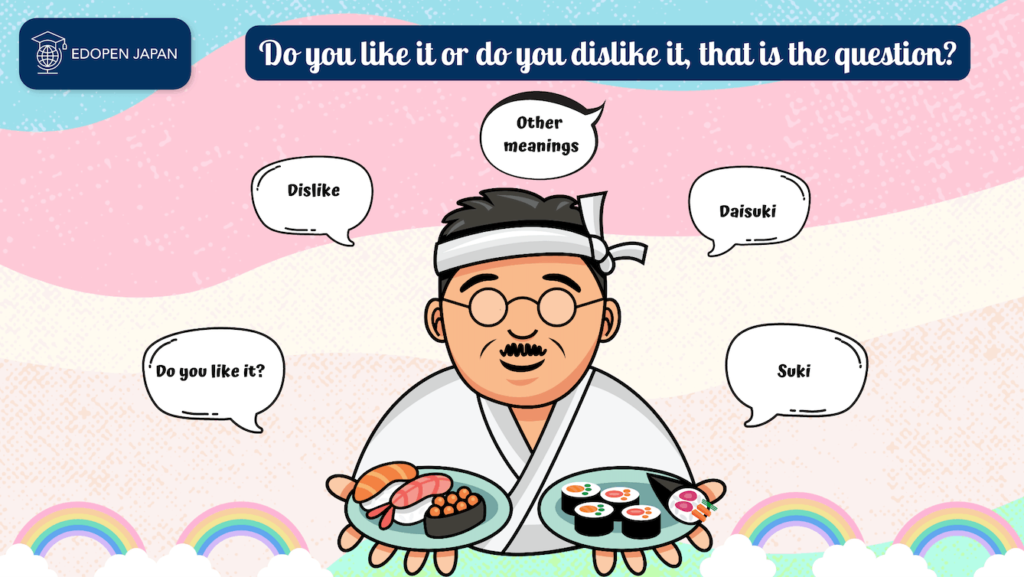
After everything, how to say that you like or dislike something is one of the most important things to be able to convey in any language. In this section, we will list some of the easiest ways to say that you like or dislike something and be able to apply the vocabulary that we have brought up in this article.
If you like certain foods
When you like food, there are many ways to refer to it, but the most common one is as the following
- _____ が好きです。
___ ga suki desu.
I like ____.
If you dislike certain foods
In Japanese, it is not common to use 好きじゃない ”Sukijanai” 、好きではありません “Suki de ha arimasen” (I don’t like). But instead the normal way would be to say
- ___ が苦手(です)。
__ ga nigate desu.
I am not good with ___.
Another polite way to express dislike
The previous expression is a more polite way of saying that something is not really your cup of tea, without completely saying that you dislike it. Another way would be to use the expression
- ___はちょっと…
___ha chotto…
___ is a bit…
If you like a particular flavor
In the case that you like sweet stuff or spicy stuff, no matter what kind the dish, you could use the next expression
- ___ものが好き(です)。
___mono ga suki desu.
I like ___ stuff.
Or
- ___ものが好み(です)。
___mono ga Konomi desu.
I favor___ stuff.
When you dislike a certain flavor
Instead, when you dislike a specific flavor, then the easiest way would be to use the same phrase as when you dislike a specific food, to then use the もの “stuff” word to refer to the whole category, the same as with when liking a certain flavor.
- ___ ものが苦手(です)。
__mono ga nigate desu.
I am not good with ___stuff. - ___ものはちょっと…
___mono ha chotto…
___ stuff is a bit…
Conclusion
As this article has shown, there are a variety of ways to refer to food and its flavors, and a variety of ways to express your flavors in Japanese.
With this knowledge, even if you are traveling alone and do not know much Japanese, you will be able to express what kind of Japanese food you like and thus be able to try new tastes and foods that are more to your liking.
Just remember to say ごちそうさまでした。”Gochisou sama deshita” after eating and いただきます!(Itadakimasu!) before eating. Want to know more about Gochisousama? Read about her here.
Anyway, if you are interested in learning Japanese and looking for reliable information about studying in Japan, our media is the right place for you. You can find more interesting articles here.

